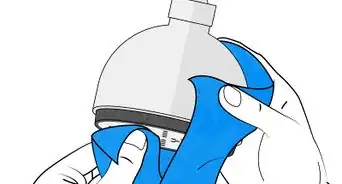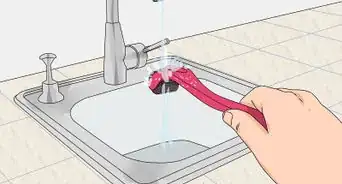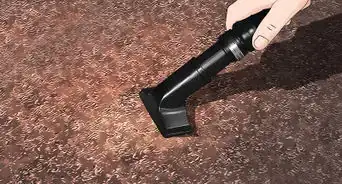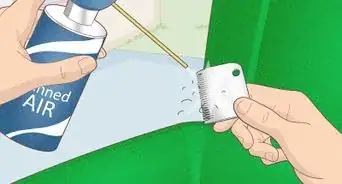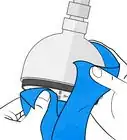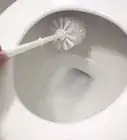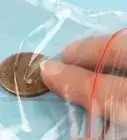This article was co-authored by Michelle Driscoll, MPH. Michelle Driscoll is the Owner of Mulberry Maids, which is based in Fort Collins, Colorado. With five years of experience, her business specializes in cleaning homes and small offices. She holds a Masters in Public Health from the Colorado School of Public Health. Additionally, Mulberry Maids has an A+ rating from the Better Business Bureau.
There are 13 references cited in this article, which can be found at the bottom of the page.
This article has been viewed 101,094 times.
There are many cleaning products designed to restore a clean shine to your shower doors, but in this case, simple homemade options are often your best bet. Established mold may take more powerful products and elbow grease, but daily prevention techniques can keep the battle weighted in your favor.
Steps
Removing Scum and Mineral Stains
-
1Wipe with a fabric softener sheet or Magic Eraser. Wipe a damp dryer sheet or Mr Clean Magic Eraser over the mineral stain and it may come off directly.[1] This won't always work, but is often a quick and convenient option to start with. Either way, rinse off the door afterward to remove the cleaning product.
- Be aware that some dryer sheets may leave scent on the shower door.
-
2Scrub with warm vinegar. Light stains from hard water or soap scum are typically easy to remove with white vinegar. Warm ½ cup (120 milliliters) of vinegar in the microwave for 30 seconds, use it to dampen a sponge or clean rag, and scrub it over the scum. Let soak for 5 minutes, then rinse off with warm water.[2]
- The vinegar may leave an unpleasant smell, but this should wash away after a shower or 2 after it dries. If your bathroom has poor ventilation, dilute the vinegar with equal parts water to prevent irritation of your eyes and sinuses.
- The soft side of the sponge is usually sufficient. The abrasive side is more effective, but can scratch some types of glass, especially if used repeatedly.
Advertisement -
3Mix the vinegar with dish soap for stronger stains. If vinegar alone won't cut through the mineral deposit, try mixing warm white vinegar with an equal amount of dish soap.[3] This should remove just about any stain in 1 or 2 scrubs, rinsing with warm water after each one.
-
4Try a specialized bathroom cleaner. A glass cleaner spray is typically less effective than acidic cleaners such as vinegar, but some specialized "shower scum removal" products may be worth a try.[4] Most of these contain ammonia, which produces toxic and irritating fumes, so use only in small quantities and in well-ventilated areas.[5] Spray on and let it sit for about 10 minutes, scrub hard with a sponge, and rinse off thoroughly.
- If your bathroom has poor ventilation, use an eco-friendly citrus-based glass cleaner. These tend to be less harmful to the eyes and lungs.[6]
-
5Try vinegar and baking soda for extremely hard stains. Use this as a last resort, since baking soda is abrasive and can scratch some types of glass, especially when used repeatedly. Pour about ¼ cup (60 mL) baking soda into a cup and slowly mix in white vinegar one tablespoon (15 mL) at a time until a thick paste is formed. Scrub this onto the glass with a sponge, let it sit for 15 minutes, then rinse off.[7]
- The two ingredients will fizz when they come into contact with each other, but the gas produced is harmless. Don't pour the vinegar directly into the baking soda, or it could messily spray out of the container.
Removing Mold and Mildew
-
1Use hydrogen peroxide. Available at drugstores, hydrogen peroxide is an effective way to kill mold. Spray it onto the mold with a spray bottle and let sit for 3 to 5 minutes, then dry with a clean towel. No scrubbing is necessary, but you may need to apply it up to 3 times.[8]
-
2Try diluted chlorine bleach. Bleach is another effective mold killer, but can irritate the skin, lungs, and eyes if used in poorly ventilated areas or when mixed with other cleaning products. Spray on a cleaning product that contains 4 to 6% bleach, let sit for a few minutes, then wipe off.
- You can dilute concentrated bleach yourself, but wear gloves and eye protection, and work in a well-ventilated area.[9]
- Never mix bleach and vinegar! Together they will create a toxic gas.
-
3Replace caulk with heavy mold. If the mold on your shower caulk cannot be scrubbed off, it has most likely penetrated the surface. Remove the caulk with a putty knife or utility knife. Clean the area with more hydrogen peroxide or bleach, then again with a cloth dampened in rubbing alcohol.[10] Ventilate the bathroom for 24 hours to ensure completely dry surfaces, then put in fresh caulk using a caulk gun.
- A caulk removal product will soften the caulk and make it easier to remove.
Keeping the Shower Clean
-
1Squeegee the doors after each use. A shower squeegee is an excellent prevention tool, wiping water and soap off the doors before water spots, soap scum, or mold can get established.[11]
-
2Spray down the tracks with a 50:50 solution of vinegar and water. Let the solution sit for about 3 to 5 minutes. Then, use an old toothbrush or grout brush to scrub out the inside of the tracks. You can also use a cotton swab or plastic knife to remove gunk and grime stuck in the corners of the shower track. Wipe away any remaining gunk from the tracks with a clean paper towel.[12]
- Repeat this at least once per month to keep the tracks clean.
-
3Keep the area ventilated and dry. Open the windows or turn on the fan during a shower, to speed up drying and minimize the time available for mold to take advantage of the moisture. Wring out washcloths and towels after use, and spread them out on the rack to dry evenly.
- If ventilation to the area is poor, consider installing a heat lamp in the bathroom.
-
4Apply a glass protector. Typically sold for use on car windows, glass shield protectors or rain repellents will repel moisture on your shower doors as well.[13] [14] Wipe on a light layer with a paper towel or microfiber cloth, let dry to a slight haze, then rub on in circular motions. Depending on the product, the type of glass, and the humidity in your bathroom, this may provide protection for anywhere from two weeks to several months.
- Read your product's label and follow the specific application instructions if they differ from these.
Community Q&A
-
QuestionWhat is an easy way to clean the front glass door?
 IDCBDCommunity AnswerA 50/50 solution of baking soda and water, or 50/50 water/vinegar and some newspaper.
IDCBDCommunity AnswerA 50/50 solution of baking soda and water, or 50/50 water/vinegar and some newspaper.
Things You'll Need
- Sponge
- Vinegar
- Glass cleaner
- Baking soda
- Liquid dishwashing detergent
Warnings
- Never mix two cleaning products, especially if one contains ammonia and the other contains bleach. Rinse the doors thoroughly between applications of different products.⧼thumbs_response⧽
- While some people use cleaners intended for non-glass surfaces, these typically work by abrasion, and can potentially scratch the glass.⧼thumbs_response⧽
References
- ↑ http://housewifehowtos.com/clean/how-to-remove-hard-water-spots/
- ↑ http://www.redbeacon.com/hg/glass-shower-doors-cleaning-guide/
- ↑ http://www.thepinjunkie.com/2013/04/how-to-clean-glass-shower-doors-easy-way.html
- ↑ http://www.redbeacon.com/hg/glass-shower-doors-cleaning-guide/
- ↑ https://www.health.ny.gov/environmental/emergency/chemical_terrorism/ammonia_tech.htm
- ↑ http://www.ewg.org/guides/subcategories/4-GlassWindowCleaner?grade=a
- ↑ http://www.homerepairtutor.com/clean-shower-doors/
- ↑ http://www.housecleaningcentral.com/en/cleaning-tips/bathrooms/shower-cleaning.html
- ↑ http://www.ag.ndsu.edu/flood/home/chlorine-bleach-safety
- ↑ http://oddrandomthoughts.com/how-to-repair-the-caulk-in-your-bathtub/
- ↑ http://www.bobvila.com/articles/clean-shower-doors/
- ↑ https://www.bobvila.com/articles/clean-shower-doors/
- ↑ http://www.homerepairtutor.com/clean-shower-doors/
- ↑ http://www.annsentitledlife.com/library-reading/twice-a-year-cleaning-secret-for-sparkling-shower-doors/
- ↑ http://www.redbeacon.com/hg/glass-shower-doors-cleaning-guide/
- ↑ http://www.bobvila.com/articles/clean-shower-doors/
- ↑ http://www.bobvila.com/articles/clean-shower-doors/#.VPnvRWZLPS8
About This Article
To clean glass shower doors, start by warming vinegar in the microwave and using a damp sponge to scrub it on hard water stains or soap scum. After letting the vinegar sit for 5 minutes, rinse it off with warm water. For stronger stains, mix warm vinegar with dish soap, scrub with a sponge, and rinse off. If you have a truly stubborn stain, try a vinegar and baking soda paste that you can scrub on with a sponge, leave for 15 minutes, and then rinse off. Finally, for mineral stains, wipe a damp dryer sheet or Mr. Clean Magic Eraser over the effected area. To learn how to remove mold and mildew from glass shower doors, keep reading!
